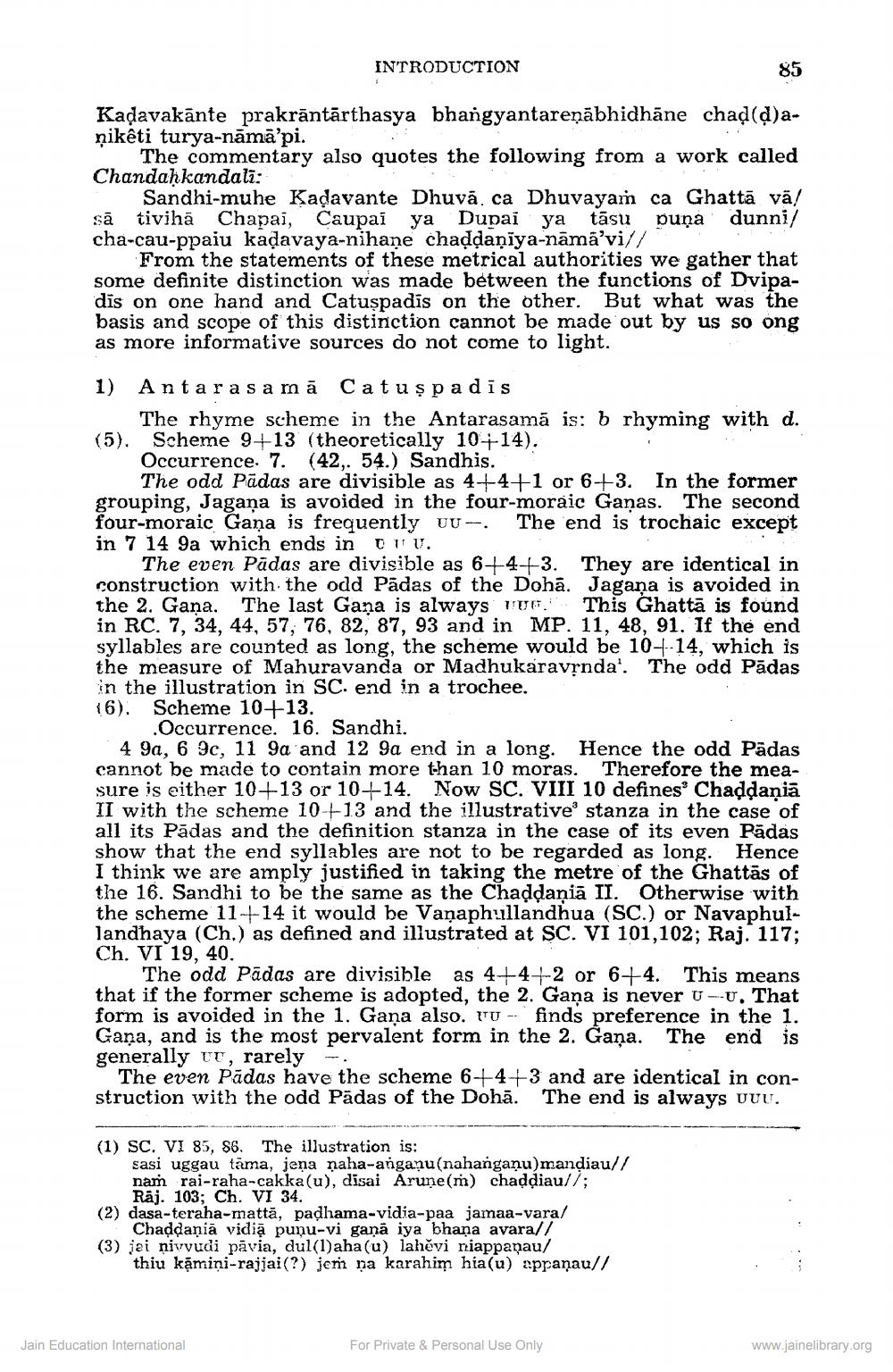________________
INTRODUCTION
85
Kadavakante prakrāntarthasya bhangyantareņābhidhāne chad(d)aņiketi turya-nāmā'pi.
The commentary also quotes the following from a work called Chandahkandalā:
Sandhi-muhe Kadavante Dhuvā, ca Dhuvayam ca Ghattā vā! sā tivihā Chapai, Caupai ya Dupai ya tāsu puņa dunni/ cha-cau-ppaiu kadavaya-nihane chaddaṇīya-nāmā’vi//
From the statements of these metrical authorities we gather that some definite distinction was made between the functions of Dvipadis on one hand and Catuspadis on the other. But what was the basis and scope of this distinction cannot be made out by us so ong as more informative sources do not come to light.
1) Antara sa mā Catus padis
The rhyme scheme in the Antarasamā is: b rhyming with d. (5). Scheme 9+13 (theoretically 10+14).
Occurrence. 7. (42, 54.) Sandhis.
The odd Pädas are divisible as 4+4+1 or 6+3. In the former grouping, Jagana is avoided in the four-moraic Gaņas. The second four-moraic Gana is frequently UU-. The end is trochaic except in 7 14 9a which ends in DTU.
The even Pādas are divisible as 6+4+3. They are identical in construction with the odd Pādas of the Dohā. Jagana is avoided in the 2. Gana. The last Gana is always UR... This Ghattā is found in RC. 7, 34, 44, 57, 76, 82, 87, 93 and in MP. 11, 48, 91. If the end syllables are counted as long, the scheme would be 10-+-14, which is the measure of Mahuravanda or Madhukaravrnda'. The odd Pādas in the illustration in SC. end in a trochee. 16). Scheme 10+13.
Occurrence. 16. Sandhi. 4 9a, 6 9c, 11 9a and 12 9a end in a long. Hence the odd Pädas cannot be made to contain more than 10 moras. Therefore the measure is either 10+13 or 10+14. Now SC. VIII 10 defines Chaddania II with the scheme 10-13 and the illustrative stanza in the case of all its Pādas and the definition stanza in the case of its even Pädas show that the end syllables are not to be regarded as long. Hence I think we are amply justified in taking the metre of the Ghattās of the 16. Sandhi to be the same as the Chaddania II. Otherwise with the scheme 11-+-14 it would be Vanaphullandhua (SC.) or Navaphullandhaya (Ch.) as defined and illustrated at SC. VI 101, 102; Raj. 117; Ch. VỊ 19, 40,
The odd Padas are divisible as 4+4+2 or 6+4. This means that if the former scheme is adopted, the 2. Gana is never u-U. That form is avoided in the 1. Gaņa also. uu - finds preference in the 1. Gana, and is the most pervalent form in the 2. Gaņa. The end is generally ur, rarely -
The even Pādas have the scheme 6+4+3 and are identical in construction with the odd Pädas of the Dohā. The end is always UUU.
(1) SC. VI 85, 86. The illustration is:
sasi uggau tama, jeņa naha-anganu(nahangaņu)mandiau// nam rai-raha-cakka(u), disai Arune(m) chaddiau/l;
Raj. 103; Ch. VI 34. (2) dasa-teraha-mattā, padhama-vidia-paa jamaa-vara/
Chaddania vidia punu-vi ganā iya bhana avara// (3) jei nivvudi pāvia, dul(1) aha(u) lahevi niappanau/
thiu kamini-rajjai(?) jer na karahim hia(u) appanau//
Jain Education International
For Private & Personal Use Only
www.jainelibrary.org




